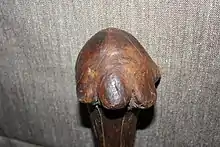Kanak war club
A Kanak war club is a traditional weapon (mace) of the Kanak tribes of New Caledonia.

Uses
Usually cut from a hardwood type of iron wood, gaiac or kohu[1] they were used for war. Like all the Pacific clubs, their forms were of a very wide variety and specific to each country and each purpose.[2] They were found in phallic form, but also in the form of fungus or bird’s beak.[3] Their striking head consisted of a root knot.[4] These weapons were originally decorated with plants, human hair, or cloths, and were wielded with one or two hands.[5]
Oceanian art specialist Roger Boulay makes a distinction between a mace, that is "an object whose percussion point is in the axis of the handle" and a club, that is "an object whose percussion point is shifted in relation to this axis".
The Kanak called the "bird beak" club a "turtle beak".[6]
Gallery
_warriors_holding_weapons%252C_New_Caledonia.jpg.webp) Kanak warriors holding clubs
Kanak warriors holding clubs Kanak mace with fungus head
Kanak mace with fungus head Kanak mace fungus type
Kanak mace fungus type Bird's beak club
Bird's beak club Kanak bird's beak club
Kanak bird's beak club Phallic mace
Phallic mace Kanak Mace
Kanak Mace
References
- La 1ère Nouvelle-Calédonie
- Susan Cochrane, Max Quanchi, Hunting the Collectors: Pacific Collections in Australian Museums, Art … Oxford Scholars Publishing
- Gustave Regelsperger, L'Océanie française: la Nouvelle-Calédonie, les Nouvelles-Hébrides, les établissements français de l'Océanie, Édition Notre Domaine Colonial, 1922, p.15
- Fergus Clunie, Fijian Weapons & Warfare, 2003, p. 136-7 et 142
- La 1ère Nouvelle-Calédonie
- Éliane Métais, Art Neo Caledonien, p.19
Bibliography
- John Charles Edler, Terence Barrow, Art of Polynesia, Hemmeter Publishing Corporation, 1990.
- Roger Boulay, Casse-Tête et Massues Kanak, 2015.
- Adrienne L. Kaeppler, Douglas Newton, Harry N. Abrams, Oceanic Art, 1997.
- Michael Gunn, William Teel, From the South Seas: Oceanic Art in the Teel Collection, Museum of Fine Arts, Boston, MFA Publications, 2006.
- André Breton, Arts primitifs, Camels Cohen, 2002.
- De jade et de nacre: patrimoine artistique kanak : Catalogue, Musée territorial de Nouvelle-Calédonie, Nouméa, mars-mai 1990, Musée national des arts africains et océaniens, Paris, octobre 1990-janvier 1991.
